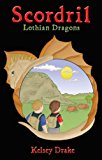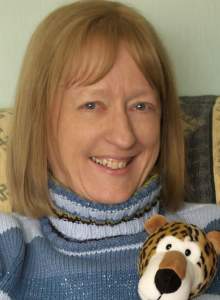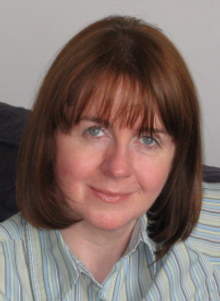 There’s a new writer in the world of children’s fiction and her name is Kelsey Drake. Kelsey’s first published book is Scordril, a novel for the 9 – 12 age group. It’s the story of a lair of dragons who are under attack from the sinister ‘night dragons’, wielding an ancient and dangerous magic. But what the readers of ‘Scordril’ may not realise is that Kelsey Drake is actually two people: Eleanor Patrick and Sue Brownless. The Crafty Writer asked Eleanor and Sue about their experience of co-authoring and self-publishing their first novel.
There’s a new writer in the world of children’s fiction and her name is Kelsey Drake. Kelsey’s first published book is Scordril, a novel for the 9 – 12 age group. It’s the story of a lair of dragons who are under attack from the sinister ‘night dragons’, wielding an ancient and dangerous magic. But what the readers of ‘Scordril’ may not realise is that Kelsey Drake is actually two people: Eleanor Patrick and Sue Brownless. The Crafty Writer asked Eleanor and Sue about their experience of co-authoring and self-publishing their first novel.

Eleanor Patrick

Sue Brownless
TCW: Why did you decide to co-author a book?
Sue: We both wanted to write a children’s book around a mix of fantasy and reality. When we met at a course and found we could spark ideas off each other, it was a natural step to try and use that. In the midst of a ‘well why don’t we’ moment we decided to write a book for a competition Eleanor had just read about. It gave us a deadline. That book was ‘Farlkris’ and it was joint runner-up for the Kelpies Prize in 2005.
Eleanor: We had the idea jointly while drinking coffee and hearing workmen outside opening up the pavement, from where the sound of dragons lurking in the depths seemed to emanate. There didn’t seem to be a problem about writing a dragon story together – though of course, we hadn’t tried at that stage, so it could have seemed rather a naive decision in retrospect. Luckily, it wasn’t.
TCW: What are the advantages and disadvantages of co-authoring?
Sue: The main advantage is that there are always more ideas, someone else to ask, the story isn’t just in one person’s head, and it helps you through those writers’ block moments. One of us always came up with a line of thought that tweaked the plot and solved the problem. Having someone waiting for the next bit to arrive is good, too. No dodging deadlines or slipping out of tricky bits. The biggest disadvantage is the logistics of getting two people to write together. We don’t live near each other and it was all done electronically.
Eleanor: The advantages are clearly two heads instead of one on the tricky business of inventing a good plot. Out of lots of options at each stage there are two people coming up with possible additional ways to deal with the event or a better alternative to brainstorm on. That has to be good, so long as you have respect for each other’s abilities, which we do. The disadvantages were mostly technical – sending sections back and forth for reading, agreement, correction and editing; making time in busy schedules to meet together for planning and decisions; agreeing the way forward for marketing and other post-publication dilemmas.
TCW: Which one of you came up with the Scordril concept?
Sue: Scordril was a character in the first Lothian Dragons outing, ‘Farlkris’. He was such a great character, with personality, he just had to have a central role in the next one.
Eleanor: It was a joint idea at the time of the other Lothian Dragons book, which we wrote first. The Kelpies Prize for a book set in Scotland had a deadline about five months after we were discussing the ‘dragons underground’ idea, so we set the book in East Lothian and proceeded from there to meet the deadline. Those Scottish visits fuelled the plot ideas for both ‘Farlkris’ and ‘Scordril’.
TCW: Did you do some preliminary work to see whether or not you could create a single voice?
Sue: We’d had a try at it with ‘Farlkris’ so it was easier and more intuitive with ‘Scordril’. We’d considered the need for a single voice that time and we even had a style sheet of things we had to remember, such as the mind speech and ‘tone’ of the dragons being different to overgrounders. But it gelled quickly and we didn’t need to keep that. The characters found their own voices and that helped us enormously.
Eleanor: No, but most of the teething problems were sorted for the first book, which is being published second, as it follows on chronologically from ‘Scordril’. For that, we wrote a style sheet to make sure we were in agreement about certain things – all stuff we do automatically now.
TCW: Is the ‘voice’ closer to Sue’s or Eleanor’s ‘solo’ voice or is it a new creation?
Sue: It is a new creation. Naturally, there will be elements of each of us in there as we write, but by the time we reached the editing stages we realised we had forgotten who wrote some of the individual passages, and genuinely couldn’t tell, so the answer to that must be no.
Eleanor: To start with, you might have deduced who wrote what – though this was not divided between “dragon” and “human” as some thought it might be. We both wrote our fair share of both events. But after editing together, there was no difference in the writing anyway. I was always staggered by Sue’s good ideas (we only had the plot outline on cards) and she was always impressed with my bits. I guess our individuality might show in which ideas we thought of as we wrote, but that isn’t a style thing so much as content.
TCW: How do you actually work together?
Sue: We look at plot – talk it through, bounce the ideas around, and a structure forms. Once we have a plot summary for the whole novel we write it on cards (full set each) so we can rearrange the order if needed and write it separately, bit by bit. We take turns throughout and both write dragon and human bits. One of us would write and then email it on for review and mark-up on screen with coloured text, then suggestions would be made where we differed or had an idea. We’d meet up with our hardcopies in hand to discuss it over a coffee, somewhere, and reach an agreement. One of us recorded the outcome in the master copy and then it was safe for the other to set away writing the next bit. That took a lot of controlling.
TCW: Did you employ an independent editor? If not, how do you maintain editorial quality control?
Sue: No, we didn’t need to. Eleanor is an editor with years of experience, so I was happy to let her have main editorial control on the grammar and such. Also, our process meant that by the final editing of the draft anyway there’d been two pairs of eyes to pick up typos our spell checks would miss and inconsistencies in plot, say, as we went along.
TCW: Is Kelsey Drake going to write other books?
Sue: Well there is ‘Farlkris’, which Kelsey wrote! We’re hoping that will be book two. Now that we know the dragons really well we’d need to tweak that a little for publication. We’ve also ensured the underlying characters/plot are pointing to a third book, with a working title of ‘Yordis’.
Eleanor: Book 2 was written first and just needs revising and editing. After that, who knows?
TCW: Are either of you working on solo projects?
Sue: I’m working on a children’s novel. It is very near to completion of the first draft. I started it when I did my MA Creative Writing at Northumbria University and it is another blend of fantasy and reality. No dragons though!
Eleanor: I am plotting a book for children set in Seahouses – I like locations that readers can visit. That’s why we wanted Lothian Dragons set in places that exist, rather than writing a pseudo-medieval fantasy. This mix of reality and fantasy does make it harder for agents and publishers to see which slot it should occupy on the shelves of bookstores – though Borders does not seem to have a problem, now Scordril is published.
TCW: From a business perspective, who handles what?
Sue: We share the publicity. Eleanor handles school visits and arranging book signings. I tend to liaise with the publisher about ordering print runs and quantities, keeping an overview of the financial aspects, and book numbers. (FYI, Sue is a qualified accountant and internal auditor – Ed)
TCW: With author percentages already so low, is it financially viable to co-author a book and split royalties in half?
Eleanor: Some years ago, Hamish Hamilton published one of my children’s books called ‘Splat!’ which was illustrated by Paula Martyr. I’ve always been sad about the splitting of proceeds (royalties and PLR) but recognise that the book was not viable without the illustrations. With Scordril, the book would not exist without the impetus of both our ideas, so yes, income is halved, but better half of something than all of nothing. We are more concerned with breaking even and getting the book out there and enjoyed than becoming millionaires at the moment. That can come next.
TCW: You’ve chosen to self-publish through Matador. This of course will give you a higher author percentage than with a mainstream publisher. Was that one of the motivating factors?
Sue: It was a conscious choice to self-publish with someone that The Writers’ and Artists’ Yearbook were prepared to recommend; we liked the look of them and their process. The higher author percentage was a factor but that is offset by the cost and risk that we as authors have to bear, and may be eroded anyway by the route the book takes to the reader.
Eleanor: No. We simply didn’t like the constant “this is a great book”, “I love the characters”, “I’d love to take this on but the market is so difficult at present” kind of replies that we were getting from agents and authors. Time was passing inexorably without us getting the deal we wanted and felt the book deserved. And it’s much more acceptable to self-publish nowadays, though it’s harder work. In retrospect, there was the plus of commissioning our own cover – most publishers consult but overrule. In one bookshop, the events manager took one look and said, “At least you’ve got a brilliant cover.”
TCW: What marketing campaign do you have planned?
Eleanor: We have done all the usual things: leaflets, flyers, phoning, showing, contacting bookshops, libraries etc, telling people with whom we’ve had connections in the past, and arranging to give talks and author visits. To keep track of all this, we set up a shared Google document, which we can both add to and comment on as we go. We also have a website and blog.
TCW: What criteria will you use to judge the success or otherwise of the Scordril project?
Sue: We’re already getting good feedback from readers and that has to be one criteria. We’re also selling well and have had to have more books printed, twice! We aim to at least cover our costs.
Eleanor: Oooh, that’s a difficult one. From my point of view, that’s writing a book that people read and enjoy as we hoped they would. In which case, even to date, that’s what we’ve done. Finishing the writing of a good book is definitely a success not to be pushed aside. So is publishing it, if you don’t lose money you can’t afford to lose. But actually connecting to readers who say how much they loved it, well that’s the fire in the dragon’s mouth. For a short time, the readers have lived what we’ve lived, and seen what we’ve seen – and that’s something you can’t put a price on.
TCW: What would you tell Crafty readers who are considering either self-publishing or co-authoring a book?
Eleanor: If that’s what you need to do for any particular project, go for it and solve the problems as you find them.
Eleanor will be signing books on Saturday 20 December at Borders, Fort Kinnaird, Edinburgh; and Sue will be joining her on Saturday 17 January 2009 at Borders Silverlink in North Tyneside, 12-4pm. Drop by and say hello. Apart from a great read, you might just pick up some tips on how to market and promote your own book.

Pingback: The Crafty Writer finds Scordril « Lothian Dragons: Scordril
Pingback: The Self Published Carnival #2 - Story Hack
Pingback: Co-publishing - pros and cons at The Crafty Writer
Pingback: Another interview with Kelsey Drake « Lothian Dragons